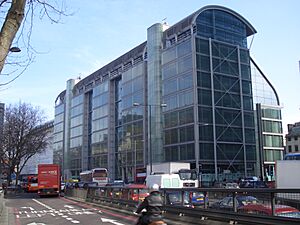Wellcome Trust facts for kids
 |
|
| Founded | 1936 |
|---|---|
| Founder | Sir Henry Wellcome |
| Registration no. | 210183 |
| Focus | Biomedical Research |
| Headquarters | London, NW1 United Kingdom |
| Location |
|
|
Area served
|
United Kingdom and overseas |
|
Key people
|
|
| Disbursements | £11 billion (1936–2015) |
| Endowment | £25.9 billion |
|
Employees
|
2,057 |
The Wellcome Trust is a charity based in London, England, that supports health research. It was started in 1936 using money left by Sir Henry Wellcome, a very successful man in the medicine business. The goal of the Trust is to "support science to solve the urgent health challenges facing everyone."
The Trust has a large amount of money called an endowment, which was worth £37.6 billion in 2025. This makes it the fourth wealthiest charity in the world. The Financial Times newspaper once called it the biggest non-government funder of science research in the United Kingdom. In the 2023/2024 financial year, the Trust spent £1.1 billion on its charity work.
Contents
Headquarters

The Wellcome Trust works from two main buildings on Euston Road in London. The Wellcome Building, built in 1932, is home to the Wellcome Collection, a free museum and library. Next to it is the modern glass and steel Gibbs Building, which opened in 2004. This is where the Trust's main offices are. The Trust also has an office in Berlin, Germany.
History of the Trust
The Wellcome Trust was created to manage the fortune of Sir Henry Wellcome. At first, its money came from a company called Burroughs Wellcome. In 1986, the Trust started selling parts of the company to the public. This was the beginning of a period of financial growth. The Trust's value grew by almost £14 billion in 14 years as it invested in areas outside of the medicine industry.
In 1995, the Trust sold all of its remaining shares in the company to Glaxo plc, a rival drug company. This created a new company called GlaxoWellcome. In 2000, the Wellcome name left the medicine business completely when GlaxoWellcome joined with another company to become GlaxoSmithKline.
What Does the Wellcome Trust Do?
The Trust's main job is to support science and research to improve people's health. It does this in many ways, from funding big research projects to helping the public understand science.
Supporting Science Research
The Trust gives money to many important biomedical research projects. Biomedical research looks at how to prevent and treat diseases in humans and animals.
Major Projects
The Trust funds or helps fund several large research projects, including:
- The Wellcome Trust Sanger Institute: A British research center that studies genomics (the study of an organism's complete set of DNA).
- UK Biobank: A large database of health information from half a million people in the UK. Scientists can use this information to study many different diseases.
- The Diamond Light Source: The UK's national science facility that uses powerful light to study everything from fossils to viruses.
- COVID-19 Research: The Trust worked with other groups to fund the search for treatments for COVID-19.
Helping Research in Asia and Africa
The Trust also supports research programs in other parts of the world. It partners with local organizations to study health problems and train scientists in countries like Kenya, Malawi, South Africa, Thailand, and Vietnam.
Making Research Better
In 2019, Wellcome started a project to improve the way research is done. Sometimes, scientists feel pressured to publish as many papers as possible. The Trust wants to change this so that the focus is on doing high-quality research that helps people, while also making sure scientists have a healthy and supportive work environment.
Sharing Research with Everyone
The Wellcome Trust is a big supporter of open access. This means it wants research papers to be free for everyone to read online. The Trust believes that when knowledge is shared freely, it helps other scientists build on the research and make new discoveries faster.
It helped launch Wellcome Open Research, a system where scientists can publish their findings quickly and openly.
Engaging with the Public
The Trust works to help everyone understand and get involved with science and health.
The Wellcome Collection
The Wellcome Collection is a free museum and library in London. Its goal is to help people understand medical science and its history. The building has galleries with art and objects, spaces for talks and workshops, a café, and a bookshop. The exhibitions are free and open to the public six days a week.
Prizes and Awards
- Wellcome Photography Prize: The Trust holds a photo contest every year. It asks photographers to explore the human side of important health challenges.
- Wellcome Book Prize: The Trust also gives out an annual prize for books about medicine and health. The prize encourages people to read and talk about these topics.
Investments
To pay for all its work, the Wellcome Trust invests its money in different businesses. For example, in 2014, it bought a large farming business. In 2015, it bought a group of marinas (harbors for boats). These investments help the Trust's endowment grow, giving it more money to spend on research.
Criticisms
Some people have raised questions about the Trust's investments. For example, it invests in drug companies, including some that made COVID-19 treatments. This means the Trust could make money from the health problems it is trying to solve.
The Trust has also been criticized for its plans to build new houses on countryside land in England. Some groups are concerned that this could harm the environment and local communities.
See also
 In Spanish: Wellcome Trust para niños
In Spanish: Wellcome Trust para niños
- Heads of International Research Organizations
- List of wealthiest charitable foundations

